
twr7cx
-
Posts
20 -
Joined
-
Last visited
Content Type
Profiles
Forums
Events
Gallery
Blogs
Posts posted by twr7cx
-
-
I'm not sure this is the right spot for this thread but I couldn't identify a general technical section of the Forum.
In regards to the front brake setups on a P38 Range Rover and a Discovery 2, does anyone know what the difference is in their front brake disc rotors? The P38 Land Rover part number is NTC8780 and the Discovery 2 Land Rover part number is SDB000380. Given that the two vehicles share the same front brake callipers (Land Rover part numbers STC1915 for LH and STC1916 for RH) and a few other parts around that area, it's likely that the brake disc rotors are not drastically different - the picture on Microcat of the setup is identical for the pair. In the rear the brake disc rotors are the same.
The reason for asking this is we are considering big brake kit options for the Discovery 2. Given the similarity of the platform to the P38 which already has big brake kit options available (e.g. Overfinch / Alcon) the easiest solution is to consider the adaption of that P38 setup to the Discovery 2.
-
Thanks all for the advise and guidance. Managed to break the taper by swinging a 4.5kg sledge hammer to hit two 4lb mallets that were held on either side of the taper by a second person like anvils. Took a few swings but all four eventually gave in.
-
 1
1
-
-
On 11/17/2018 at 11:14 PM, bear said:
Hi, Have a look here for the parts numbers
http://new.lrcat.com/#!/1232/35470/35580/2694/35619
HTH,
Griff
On 11/17/2018 at 7:54 AM, jalmassi said:My only problem now is the Lemforder ball joints didn't come with nuts...!!! I've got one to fit the top but can't find out what thread the bottom one has, always something.
Upper nut - NY214043
Lower nut - NY216043
You can likely find suitable replacements at a local bolt and nut specialist.
I didn't think of organising new nuts when I ordered the replacement ball joints - just assumed that they would be included. They should arrive by the end of this week, hopefully they're in the box too but I'm pretty sure I went with Lemforder brand so unlikely...
-
Top and bottom ball joint boots have splits in them and given that the vehicle is now 16 years old with 280,000km it's time to replace them. I've stripped it all down now (wheel, brakes, CV shaft off, etc) and just have the knuckle attached to the diff through the ball joints.What's the hot tips for separating the steering knuckle (i.e. breaking the ball joints tapered/rust bond)?
I'm always weary of the BFH method.
I've tried an air hammer with a ball joint separating fork and a manual one and can't get in very far before the tip of the fork fouls somewhere on the knuckle.
Special separator tool (yes, I know there is a genuine Land Rover one, but is there a more accessible alternative?)? The one I have here for ball joints/tie rod ends seems to be a bit too small.My pullers, including a decent hydraulic one, just don't seem to able to fit on properly on the bottom ball joint and the top is inaccessible to them. -
I didn't get around to checking the wastegate arm on the weekend, ran out of time, but I ended up having the ECU tune adjusted with the software clamps for the MAF applied and the MAP range extended up to 4.80v. This has solved 90% of my issues. I have some minor stuttering and shuddering at highway speeds (above 80km/h) when attempting foot flat accelerating now. The vehicle actually looses road speed when trying this, but backing off a bit on the accelerator pedal and the acceleration picks back up. Not ideal but the vehicle is usable again now and I can drive accordingly (I rarely ever put my foot flat previously anyway).
-
There is some really interesting reading available on http://www.discotd5.com including, if you dig deep enough, some comparisons on different tuners maps. Generally though, it would seem that previously tuners were a bit limited in what they were/could modify and due to this the electric trickery solutions came about (turbo boost boxes, dual channel variants, variants for the MAF too and modified MAFs) or physical solutions (such as disconnecting the MAF or air bypasses). It would seem that the research and investigation further into the Td5 map tuning by Paul and his associates documented on that site, has opened up the potential within the tuning to resolve these issues through the tune itself. Judging from this link https://bellautoservices.co.uk/store/td5-1-4-bar-boost-ecu-recalibration/ it looks like Bell Auto Services have adopted this for the MAP.
-
Cheers, I have sent Jose from TD5Inside an e-mail to see if he can modify my remap tune to suit.
When you say high end MAP are you referring to an uprated MAP sensor such as http://td5inside.pt/uprated-sensors or https://www.lro.com/land-rover-parts-and-gear/uprated-td5-map-sensor - which I assume would also need the remap tune adjusted for.
-
Thanks. I will check it over the weekend and test it purely so that I'm not chasing my tail by ignoring what could be the issue, but I'm fairly certain that it's not the case for the following reasons:
1. if the wastegate was seized or partially seized the turbo charger would have more exhaust flow going through it causing it to spin faster and increased boost levels. This is not the case. My vehicle is still peaking at 21psi exactly as it has done for the last five years. For general cruising and normal drivings it's usually around 10 to to 16psi as per normal since installing the VNT.
2. If the wastegate was seized or partially causing the additional flow the IRB Developments Two (Dual) Channel Turbo Boost Box, if it was working, should have still be intercepting the signals for the MAP and MAF and ensuring that they're not going high enough to upset the ECU.
I could see why on a standard TD5 a seized or partially seized wastegate would cause issues as it would result in the turbo running higher and producing more boost which if high enough would upset the ECU, but being standard it wouldn't have the electronic interception devices to prevent the ECU receiving a signal that it's too high.
Anyway, I do intent to still check to eliminate it as a cause.
-
I'm interested to know what methods others are using for the MAF issues that arise when running larger turbos/VNT/VGT or sometimes even the standard turbo with the waste gate adjusted a lot.
One method I have seen but not tried myself, is the MAF bypass hose - I believe for this a secondary output is put from the air filter box to the rocker cover breather connection on the pre-turbo air intake pipe allowing some air to bypass the MAF and enter without having been metered by the MAF. Anyone had issues prior and then success using this method?
Previously Alive Tuning (formerly TD5Alive) offered a modified MAF which worked. I notice that it is not listed on their website and if I recall it wasn't previously either, I think you had to contact them directly. Sadly it was based on the aftermarket MAFs and the quality was horrendous - it started separating in the first week I had it. I also had concerns about the automatic transmission as there are many stories about it acting strange or gear shifts being rough due to aftermarket MAFs which are resolved when the genuine item is installed.
I then replaced this with a genuine MAF and the IRB Developments Two-Channel Turbo Boost Box (two channel as one does the MAP signal as per the other Turbo Boost Boxes available, but the second channel does the MAF signal). This has worked well since fitting and adjusting in early 2013 but recently my D2a TD5 is running crud (check out IRB Developments Td5 Dual/Two Channel Turbo Booster Box adjustable tuning instructio? for error details) and I suspect due to a failed IRB Developments Two-Channel Turbo Boost Box. I have checked the wiring loom, connections and power and earth to it. Sadly due to the black stuff they put all over the circuitry I cannot test or see if there is any issue in there.
So, I'm hesitant to modify the air filter box (but probably shouldn't be as I'm sure a new lid can be easily sourced from a wrecker), have concerns on returning to the Alive Tuning MAF due to the build quality and Ian at IRB Developments is ignoring my e-mails, Facebook Messages (of which Facebook advises he has received) and What'sApp messages so I don't seem to be able to purchase a replacement and am therefore curious if in the six years that have elapsed since I last looked into this there have been any further developments or options arise?Also found Diablo Demon Tuning which offer their M.A.F. Demon Land Rover TD5 MAF controller performance tuner . I'm not sure that it actually does what I'm trying to achieve though, I think it might do the opposite? They seem to also make their version of a turbo boost box for the MAP sensor called the Boost Demon which is a quiet neatly packaged to sit next to the sensor itself with the original wiring loom plugging straight in - Land Rover TD5 performance Pro Boost controller boost box and fueling adjustment .But there seems to be no purchase options or contact details on there site to discuss further? Strange.
-
On 21/05/2018 at 6:08 PM, lo-fi said:
Are you absolutely certain the real issue isn't that the wastegate is seized or partially seized?
Any advise on how to check? I'm running a Turbo Technics VGT supplied by Bell Auto Services. I have a boost gauge tapped into the inlet manifold and the boost levels are exactly as I would expect them to be with no change in normal driving.
I did some diagnosing this evening and I believe that the IRB Developments Two Channel Turbo Boost Box has failed. I adjusted it significantly and it has had no effect on the readings using the Nanocom Evolution, both my MAP and MAF readings are far to high and I can't get them down by adjusting. I have checked the wiring loom, connections and power and earth to it. Sadly due to the black stuff they put all over the circuitry I cannot test or see if there is any issue in there.
-
I wasn't able to get the instructions from Ian/IRB Developments, but a members of AULRO had a copy and forwarded them to me. For future reference for anyone else, they are:
Quote> Instructions:
>
> 2 channel adjustable 'Anti Limit Box'
>
> Red - 12volt Ignition live or permanent 12v feed (seperate from any feed into the ECU)
> Black - Earth (good)
>
> Yellow (orange) and white are the channel wires - one is for MAF and one is MAP (as per standard boost box). It doesn't matter which way round (obviously they need to be used as a matched pair).
>
> MAF is pin 11 in the red plug (grey wire, green chaser on post 2002) (one from end of the bottom row)
> MAP is pin 6 in the red plug as per a standard boost box. (middle of the bottom row)
>
> The box is set in a safe setting.
>
> The channel connected to the map sensor will be somewhere close, but the maf sensor channel will need quite a few turns clockwise (usually about 4 turns)
>
> Your are aiming to see around 220kpa on the manifold pressure and 620-630kg/hr on the maf sensor under full throttle acceleration when set correctly. This should also stop you killing MAF's.
>
> MAF sensor must be a genuine part, and at idle it should be reading 57 - 62 kghr
>
> To get the pins out of the ECU plug, remove the white anti back out plate and use a pick or small flat bladed screw driver to release the standard pin - look from the front of the plug (not the wire side) and you will see the small tab holding the original wire in place.
>
> Regards
>
> Ian Baughan
>
> IRB Developments
>
> or follow us on Facebook - IRB Developments - Home | FacebookUsing my Nanocom Evolution to data log while driving it would seem that both my MAF and MAP are over where they should be. I've seen above 650kg/hr reading from the MAF and then it's flashed down to O, which I suspect might be due to overload or more air through than it can read?, and the MAP reading has been well above 220kpa which I suspect is triggering the overboost issue.
-
Anyone have the instructions handy for adjusting/tuning the IRB Developments Dual/Two Channel Turbo Booster Box for Td5? I bought and fitted mine in around 2013 and seem to have misplaced the guidance since then (thankfully I haven't had a need to touch it). I'm currently have intermittent issues with the vehicle including surging and power cut off (suspected due to over boosting) so am trying to determine if the fault is the MAF or Turbo Booster Box is faulty or requiring adjustment.
Nanocom Evolution spat out the following when I read the codes yesterday (it's been a long time since I've pulled them):
(1,5) DRIVER DEMAND PROBLEM 1, (LOGGED LOW).---
(2,8) AMBIENT PRESSURE CIRCUIT, (LOGGED LOW).
---
(3,5) DRIVER DEMAND PROBLEM 1, (LOGGED HIGH).
---
(3,7) AIR FLOW CIRCUIT, (LOGGED HIGH).
---
(4,1) INLET AIR TEMPERATURE CIRCUIT, (LOGGED HIGH).
---
(4,3) COOLANT TEMPERATURE CIRCUIT, (LOGGED HIGH).
---
(15,2) HIGH SPEED CRANK (LOGGED).
---
(16,2) HIGH SPEED CRANK (LOGGED).
---
(19,3) CAN TX /RX ERROR, (LOGGED).
---
(20,2) TURBOCHARGER OVERBOOSTING, (LOGGED).
---
(20,5) EGR VALVE STUCK CLOSED, (LOGGED).
---
(22,1) ROAD SPEED MISSING, (LOGGED).
---
(26,1) ROAD SPEED MISSING, (CURRENT).
---
(27,4) INJECTOR 4 PEAK CHARGE LONG, (LOGGED).Todays code read:
(3,5) DRIVER DEMAND PROBLEM 1, (LOGGED HIGH).---
(20,2) TURBOCHARGER OVERBOOSTING, (LOGGED).
---
(22,1) ROAD SPEED MISSING, (LOGGED).
---
(24,3) OVERBOOST HAS OCCURRED THIS TRIP, (CURRENT).
---
(26,1) ROAD SPEED MISSING, (CURRENT).
---On the drive home today I pulled over while it was underpowered and disconnected the MAF sensor which instantly fixed it. Hence why I have narrowed it down to either the MAF or Booster Box.
-
155NM on an M12(?) bolt? Surely that can't be right...
Rave specifies 230nm for the centre bolt (watts linkage pivot to rear diff), 155nm for the watts linage centre piece to the arms and 140nm for the arms to the chassis.
-
Has anyone here had any experience with Flo-Flex bushes for the watts linkage on a Discovery 2?A member on AULRO < Watts Linkage bushes, Flo-Flex v OEM - Page 3 - Australian Land Rover Owners > purchased and attempted to fit them but found that they crushed when being tightened to the specified torque setting - apparently this occurred at only 100nM when the specified torque setting is 155nM:

 When contacted about torque settings for their products Flo-Flex have provided the following vague advice:If you look at the design of ours, you can see there is a lip that you press the bush to. Therefore it is unnecessary to use these torque settings.Kind Regards,Rich.- flo-flexI have done a few searches and the only discussion that I have found on this product is < http://www.landyzone.co.uk/lz/f8/rear-watts-bushes-266066.html > and provides little detail.I am interested to know if anyone else has had experience with the Flo-Flex watts linkage bushes?
When contacted about torque settings for their products Flo-Flex have provided the following vague advice:If you look at the design of ours, you can see there is a lip that you press the bush to. Therefore it is unnecessary to use these torque settings.Kind Regards,Rich.- flo-flexI have done a few searches and the only discussion that I have found on this product is < http://www.landyzone.co.uk/lz/f8/rear-watts-bushes-266066.html > and provides little detail.I am interested to know if anyone else has had experience with the Flo-Flex watts linkage bushes? -
Does this have interesting implications? Seals are moulded compoments, and if Land Rover changed suppliers presumably the new suppliers had to make new tooling, and a mistake has occured. But that should not effect Allmakes, Britpart etc, who will be using suppliers who have their own tooling and will continue to make seals to the correct sizing. These alternative manufactures will not change their tooling just because Land Rover have, unless of course all seals come from one supplier, and the terms OEM and pattern parts are meaningless.
Or have Land Rover changed the specification as a deliberate act, and every one has followed suit on their advice. Has any one asked LR about it?
It would seem that the Britpart, AllMakes4x4 and Land Rover brand seals are all coming from the same factory - they have identical markings, design, colour etc. now.
If I had a contact number for Mr Land Rover I would certainly ask them about it, but my local Land Road sales and spare parts dealer knows nothing about any of it and we're a long way from their head office...
-
And another one - http://www.thed2boysclub.co.uk/viewtopic.php?f=5&t=13199&p=177199&hilit=bahe#p177199Seeing a pattern forming?Note that the effected users are from all various parts of the world too.
-
Another good thread for anyone interest in this further is http://www.aulro.com/afvb/discovery-2/192615-ashcroft-hd-cv-shafts-front-diff-seals-leaking-5.html
-
Cheers, I have requested registration on thed2boysclub and am awaiting approval to be able to view that link.
-
Has anyone who has recently fitted new axel shaft seals to their front diffs experienced continual issues with them leaking?A number of us in Australia are finding this issue and we believe that the cause may be that the new seals are being produced slightly smaller (35mm vs 36mm ID):
 The result is that the main body of the seals seems to grip on the shaft and eventually tear itself apart:
The result is that the main body of the seals seems to grip on the shaft and eventually tear itself apart: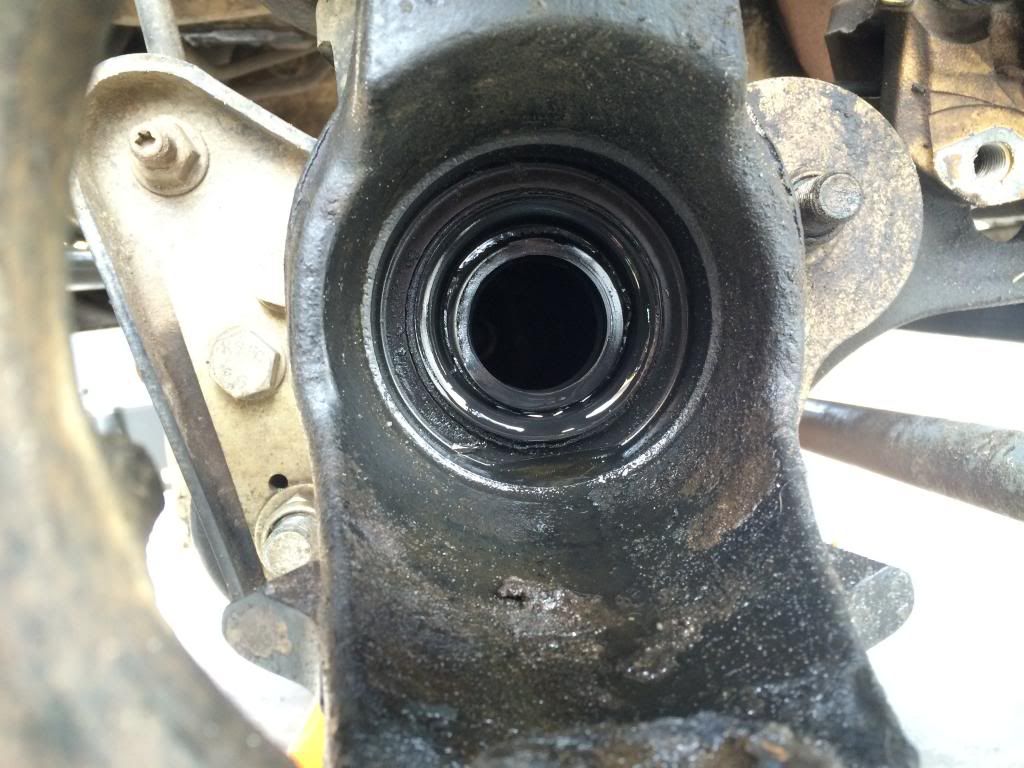
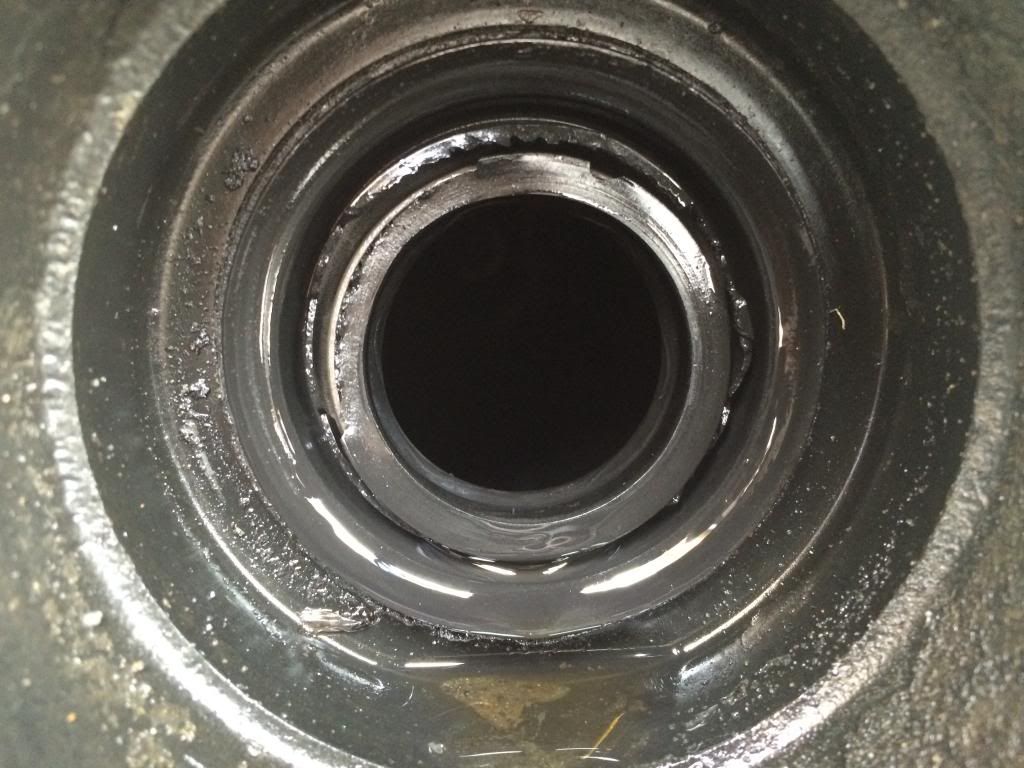
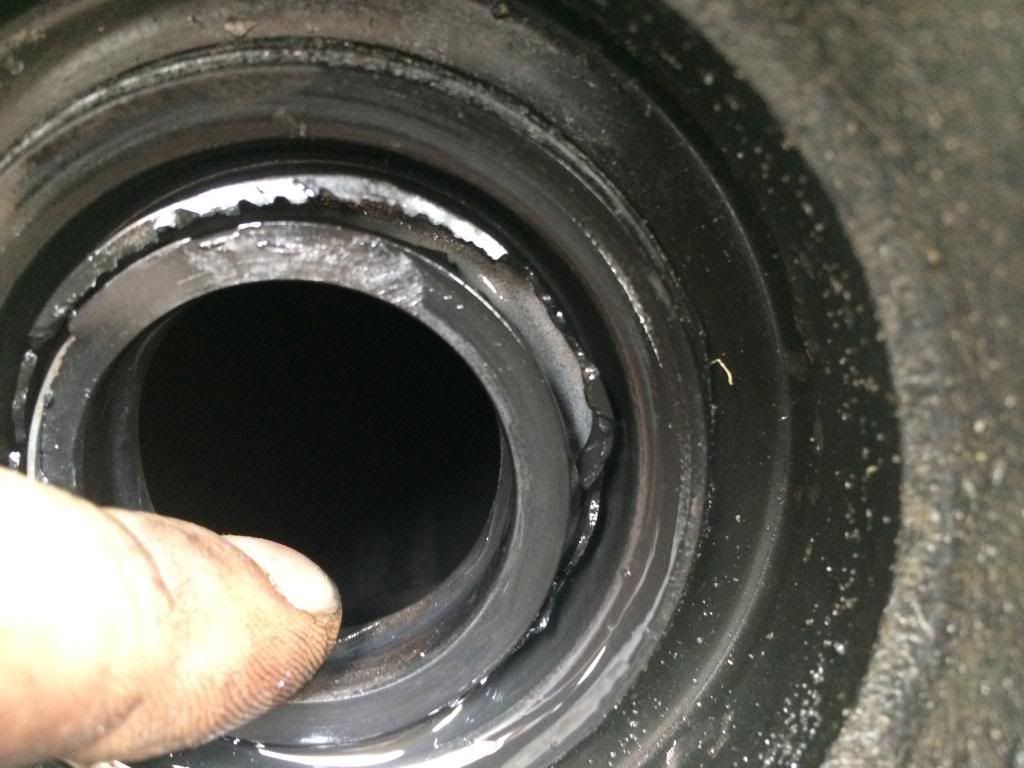
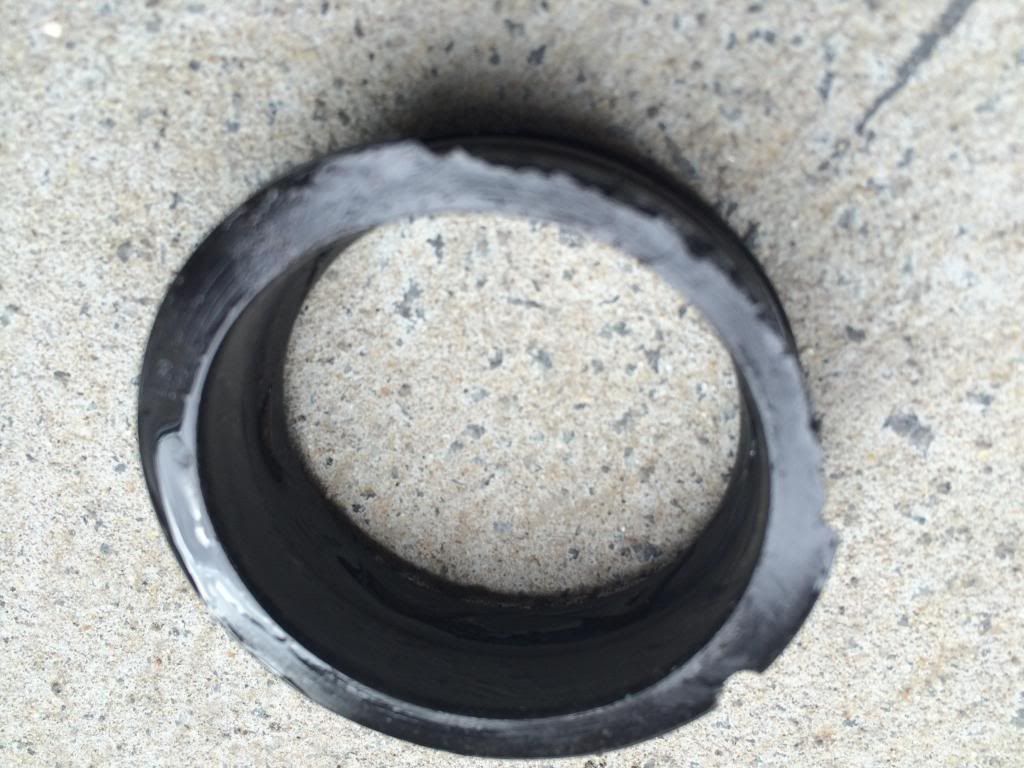
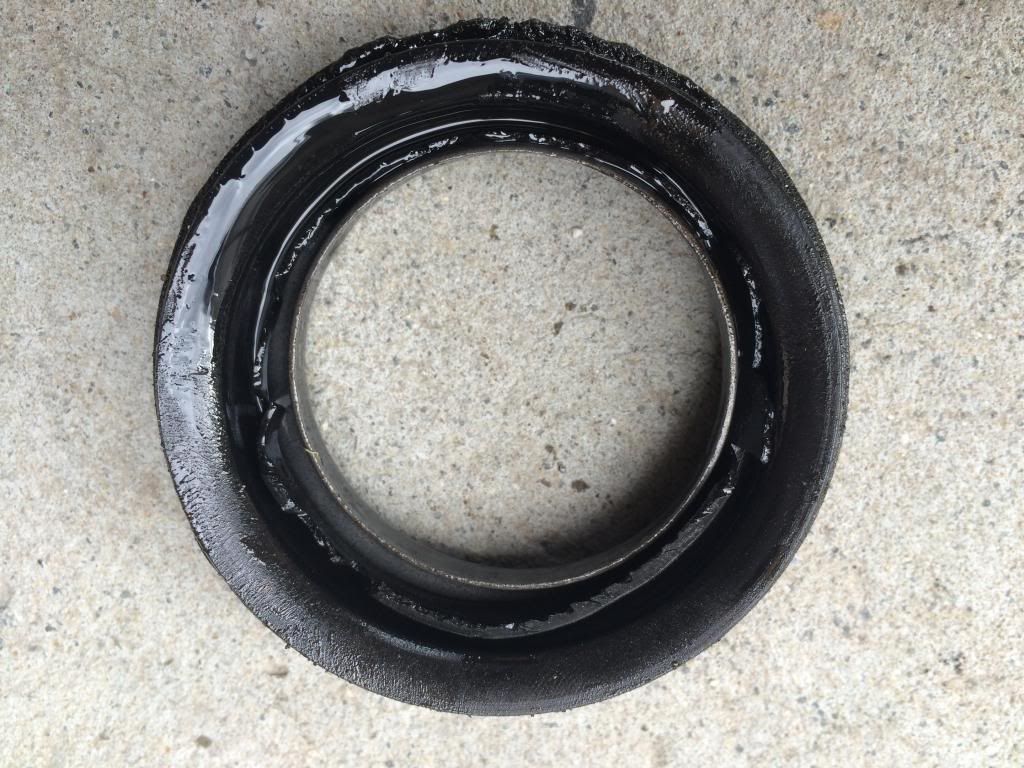
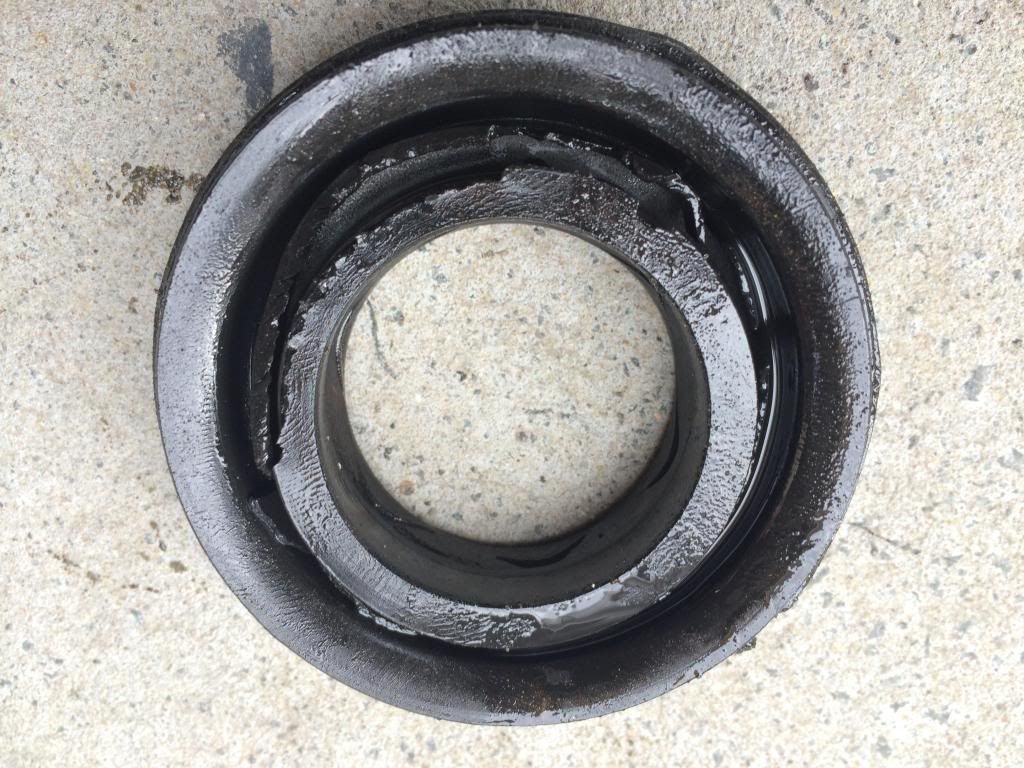 We have measured the genuine Land Rover, AllMakes4x4, Britpart (who are supposebly the OEM supplier for this part), Corteco (who seem to be the actual OEM supplier) and Bearmach and found all to be 35mm ID of the seal body.However, some members with old seals have measured them to be 36mm (1mm larger).The shafts measure 34.98mm which are the cause of why the seals are gripping and failing.Wondering if there are any other seal options available in that may be the correct size? Apparently there is a NAK brand with possible part number of SG9AYW2 (but Google turns up nothing and NAK Australia don't recognise it) which may be the correct size but so far we have been unable to source it.
We have measured the genuine Land Rover, AllMakes4x4, Britpart (who are supposebly the OEM supplier for this part), Corteco (who seem to be the actual OEM supplier) and Bearmach and found all to be 35mm ID of the seal body.However, some members with old seals have measured them to be 36mm (1mm larger).The shafts measure 34.98mm which are the cause of why the seals are gripping and failing.Wondering if there are any other seal options available in that may be the correct size? Apparently there is a NAK brand with possible part number of SG9AYW2 (but Google turns up nothing and NAK Australia don't recognise it) which may be the correct size but so far we have been unable to source it.


Front brake rotors: P38 NTC8780 vs Disco2 SDB000380 difference?
in International Forum
Posted
Thanks Filip.